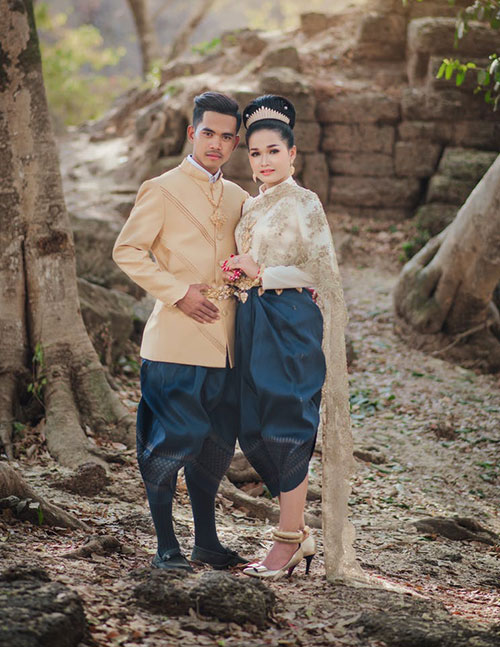 Men and women in Cambodia wear a traditional garment for the lower body called “sampot”. There are many variations of this skirt – sampot chang kben, sampot charobab, sampot lbaeuk, etc – depending on the design, wearer’s status, purpose of the attire, and so on. A sampot has been widespread in Southeast Asia since the 1st-6th century A.D. And even today, Khmer men and women continue to wear sampots for special occasions or in daily life.
Men and women in Cambodia wear a traditional garment for the lower body called “sampot”. There are many variations of this skirt – sampot chang kben, sampot charobab, sampot lbaeuk, etc – depending on the design, wearer’s status, purpose of the attire, and so on. A sampot has been widespread in Southeast Asia since the 1st-6th century A.D. And even today, Khmer men and women continue to wear sampots for special occasions or in daily life.
Basically, a sampot is a long rectangular piece of cloth worn around the lower body. It’s the traditional garment in Cambodia, popular among both men and women. Very often, sampots, especially festive or high-class ones, are made from silk, as this fabric is common in Cambodia.
The design of a sampot can be rather diverse. There are longer and shorter sampots, monochromatic and colorful, adorned with prints or embroidery, etc. Most often, the width of this skirt is about 1.5 m. And by the way, a sampot is typically sewn into a tube for convenience. The wearer ties the excess fabric into a knot at the waist and secures it with a belt. Sometimes, this knot is pulled between the legs so that a sampot forms a sort of trousers.

Khmer bride and groom wearing sampots as wedding attire
Some Cambodians still wear a sampot on a daily basis – for example, men and women from the lower classes. But even those Cambodians who dress in casual Western-style clothes in daily life prefer to wear a sampot and other traditional clothing for such occasions as a wedding, formal meetings, religious ceremonies, and so on.
Several common variations of a sampot
Sampot chang kben – a piece of cloth (3 to 1 m) worn as pants – the fabric is knotted, pulled between the legs, and secured at the waist. This garment in the past was used by upper and middle-class people as daily wear. Fits both men and women.
Sampot chang samloy – a long unisex daytime skirt that derives from Indian lunghi. It is secured with a knot at the waist and has a fold at the right or left hip.
Sampot tep apsara – an ankle-length skirt that has long pleats in the front and 2 knots at the waist (one on the right and one on the left). A belt is used as well to secure the skirt.
Sampot charobab – a long silk skirt embellished with gold embroidery. This garment is used in Khmer folk dancing and ceremonies, and also by Cambodian newlyweds.
Sampot seng – a short embroidered silk skirt.
Sampot anlonh – a long skirt with vertical stripes. This garment is popular among the older people and farmers in rural areas.
Sampot sesay – a plain-colored skirt with a gold-embroidered or silver-embroidered band at the hem. These days, such a skirt is more common in Laos than Cambodia.
Sampot lbaeuk – a long silk-embroidered skirt often worn as wedding attire.
A sampot is a cute and very comfy garment for the lower body, especially when we’re talking about the hot and humid Cambodian climate. You can wear it as a skirt or quickly turn it into trousers – a really handy option. Festive sampots are usually vividly colored and decorated with various prints, silk embroidery, or gold and silver embroidery, so they’re beautiful and bright.


